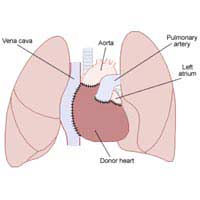How Successful Are Heart-Lung Transplants?

A heart transplant is one of the most technically demanding operations that modern medicine is able to offer. The first successful heart and lung transplant only took place in 1981 and have been pioneered by a group of surgeons at Stanford University in the USA. The number of transplants done since then has increased steadily but slowly and just 75 were done anywhere in the world in the whole of 2004.
As with many transplant operations, success rates continue to improve and the National Health Service latest figures show that 73% of people who now have a heart and lung transplant are likely to survive for at least one year.
Who Has a Heart and Lung Transplant?
Around half of all heart and lung transplant operations that are done are on people with a congenital lung problem, or the genetic disease cystic fibrosis. The people affected tend to be young when their heart and lungs are in danger of failing altogether. With a heart and lung transplant, they can recover to gain many years of active life. The other group of people who required heart and lungs to be transplanted at the same time are people affected by pulmonary hypertension. This occurs when the blood leaving the heart to go to the lungs is at a higher pressure than normal, which damages the delicate lung capillaries and leads to heart failure.In order to be eligible for a transplant of this kind, it is important that the recipient has no other complicating or underlying illness, such as diabetes, or infection such as HIV or hepatitis. As with other people who have organ transplants, it is necessary for heart and lung transplant patients to take drugs to suppress their immune system for the rest of their life, to prevent them from rejecting their new organs.
What Does a Heart and Lung Transplant Involve?
The nature of the lungs means that transplantation can only take place if the donor lungs are in very good condition. Donors and recipients are matched as closely as possible according to blood type and also the HLA antigens. These are unique to each patient, but there are broad and specific markers that can be matched to try to minimise rejection. Unfortunately, even a very good match does not guarantee that the lungs will arrive from the donor in a healthy enough state to be transplanted. If there has been a delay in transport, they might not be suitable for the operation.For this reason, to avoid the recipient undergoing removal of their lungs and heart and then not having replacements, heart and lung transplants are only started once the donor lungs have arrived in the hospital where the operation will take place and after they have been checked and passed. This causes a significant delay, as the operation to remove the recipients own organs takes several hours, but there is no way to avoid it.
The patient receiving the new heart and lungs is connected to a heart and lung machine and the new organs are attached using the major blood vessels. As soon as this is done, the lungs begin to work and the heart begins to beat. Once this has maintained a stable rhythm for a long enough period, the heart and lung machine is closed off and the circulation through the new organs and the recipient’s body is checked. Only then is the chest closed up and the patient removed to the recovery room.








